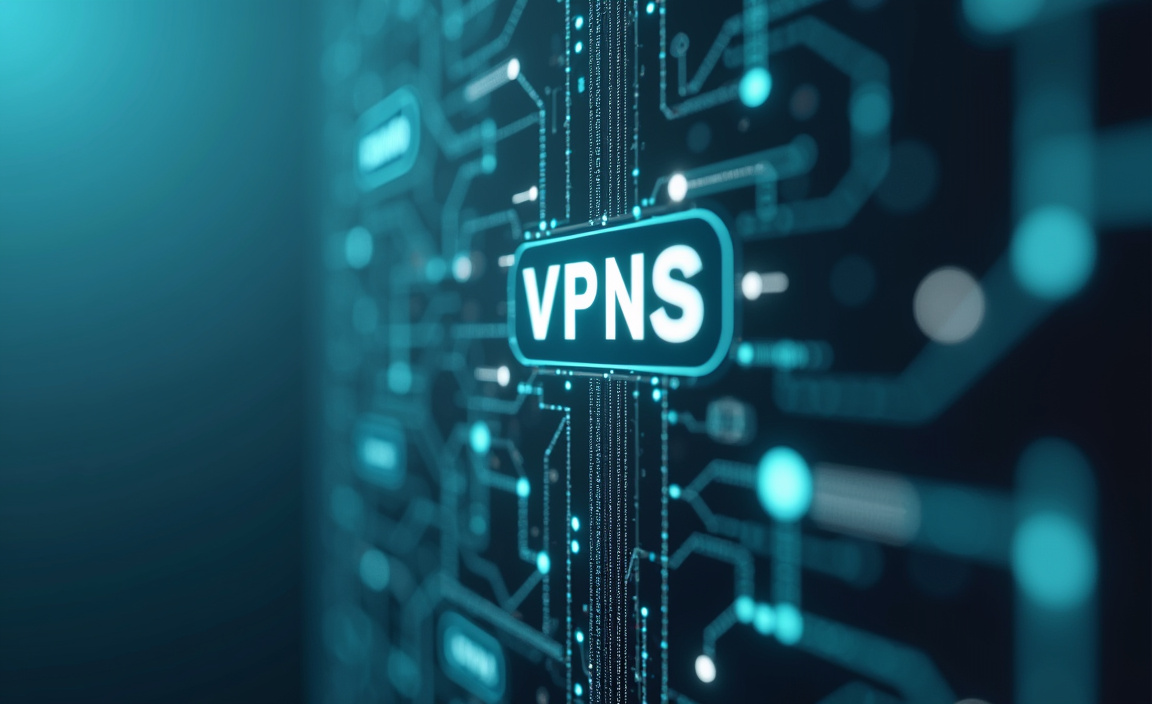VPNs for Environmental Monitoring: Securing Sensor Data

Table of Contents
Introduction: Safeguarding Environmental Research with VPNs
In an era defined by escalating climate change and environmental degradation, the importance of accurate and reliable environmental monitoring cannot be overstated. From tracking air and water quality to monitoring deforestation and wildlife populations, environmental sensors deployed across diverse landscapes play a crucial role in providing the data necessary for informed decision-making and effective environmental protection strategies. Faced with the increasing urgency to understand and mitigate environmental changes, the role of technology in collecting and transmitting crucial data has become indispensable.
Environmental sensors, ranging from sophisticated weather stations to underwater acoustic monitors, are deployed across diverse and often remote locations. These sensors gather a constant stream of vital information, providing insights into everything from air and water quality to soil conditions and wildlife behavior. This data forms the foundation upon which informed decisions are made regarding environmental policy, conservation efforts, and resource management.
However, the very nature of these sensor networks, often deployed in remote or unsecured locations, makes them vulnerable to a range of cybersecurity threats that can compromise data integrity, confidentiality, and ultimately, the effectiveness of environmental safeguard efforts. Unlike traditional IT systems that operate within controlled environments, environmental sensor networks face unique security challenges. Sensors may be located in areas with limited physical security, making them susceptible to tampering or theft.
Furthermore, the communication channels used to transmit data, such as wireless networks or satellite links, can be vulnerable to eavesdropping and interception. This is where the strategic implementation of Virtual Private Networks (VPNs) tailored for environmental monitoring becomes paramount. An 'environmental monitoring VPN' acts as a secure tunnel, encrypting data transmitted between sensors and central data repositories, shielding it from potential eavesdropping, tampering, or malicious interference.
Much like a secure pipeline protecting valuable resources, an 'environmental monitoring VPN' encrypts data in transit. Imagine a network of weather sensors scattered across a vast forest. Without a VPN, the data transmitted from these sensors could be intercepted, revealing sensitive information about weather patterns and potentially allowing malicious actors to manipulate the data.
A VPN envelops this data in a layer of cryptographic security, rendering it unreadable to unauthorized parties. Securing 'sensor data security' is not merely about preventing unauthorized access; it's about ensuring 'data accuracy protection' essential for generating reliable insights and supporting evidence-based environmental policies. Compromised data can lead to flawed analysis, incorrect conclusions, and ultimately, ineffective environmental policies.
Consider a scenario where data from air quality sensors is manipulated to show lower pollution levels than actually exist. This could lead to a relaxation of environmental regulations, resulting in increased pollution and harm to public health. This highlights the critical need for data accuracy protection.
The challenges inherent in securing environmental sensor networks range from the logistical difficulties of deploying robust security measures in remote locations to the resource constraints often faced by environmental organizations. Power constraints, limited bandwidth, and the need for cost-effective solutions are all factors that must be considered when designing a secure environmental monitoring system. Furthermore, the diverse nature of sensor technologies and communication protocols requires a flexible and adaptable security solution.
A single environmental monitoring network might incorporate sensors communicating via different protocols like LoRaWAN, cellular networks, or even satellite uplinks. A successful VPN solution must accommodate this diversity. A well-designed VPN solution addresses these challenges by providing a centralized and manageable security framework that can be customized to meet the specific needs of different deployments.
It provides an adaptable security solution capable of integrating with existing infrastructure. The selection of an appropriate 'VPN for sensors' involves careful consideration of factors such as encryption strength, bandwidth requirements, power consumption (particularly relevant for battery-powered sensors), and the ability to seamlessly integrate with existing sensor infrastructure. Beyond the technical considerations, it is crucial to recognize the ethical implications of data security in environmental monitoring.
The data collected by these sensors often informs policies and regulations that have significant social and economic consequences. Therefore, ensuring the accuracy and reliability of this data through robust security measures becomes a moral imperative. Environmental organizations have a responsibility to protect the integrity of their data, both to uphold the public trust and to ensure that environmental policies are based on sound scientific evidence.
The integration of VPN technology into environmental monitoring systems represents a proactive step towards safeguarding environmental data and promoting 'environmental safeguard', enhancing.
The core function of an 'environmental monitoring VPN' lies in establishing a secure, encrypted connection between the environmental sensors deployed in the field and the central data processing and analysis systems. This encryption process transforms the raw sensor data into an unreadable format, preventing unauthorized access and protecting against eavesdropping by malicious actors. Think of it as creating a private, protected tunnel through the public internet.
Without this tunnel, the data would be exposed, like sending sensitive information on a postcard. The strength of the encryption algorithm employed is a critical factor in determining the overall security of the VPN. A weak encryption algorithm is like a flimsy lock that can be easily picked, whereas a strong algorithm provides robust protection against even the most sophisticated attacks.
Advanced Encryption Standard (AES) with a 256-bit key is widely considered to be the industry standard for strong encryption, providing a high level of security against brute-force attacks. This level of encryption is so strong that it's used by governments and financial institutions to protect highly sensitive data. The selection of appropriate VPN protocols is another important consideration.
VPN protocols are the set of rules that govern how data is transmitted over the VPN connection. Different protocols offer different levels of security, speed, and compatibility. OpenVPN is a popular and versatile protocol known for its robust security and compatibility with a wide range of devices and operating systems.
Its open-source nature allows for continuous scrutiny and improvement by the security community, making it a reliable choice. IKEv2/IPsec is another commonly used protocol that offers excellent speed and stability, particularly on mobile devices. This protocol is often preferred for applications where speed is critical, such as real-time monitoring of remote equipment.
WireGuard is a relatively new protocol that is gaining popularity due to its simplicity, speed, and strong security. Its leaner codebase promises to be faster and potentially more secure than older protocols, but it is still relatively new and may not be supported by all devices. Beyond encryption and protocol selection, a comprehensive 'sensor data security' strategy must also address the vulnerabilities associated with data transmission.
Man-in-the-middle attacks, where an attacker intercepts and alters data in transit, are a significant threat to environmental sensor networks. Imagine an attacker sitting between the sensor and the data server, secretly reading and modifying the data as it passes through. A robust VPN implementation includes mechanisms to prevent such attacks, such as mutual authentication, which ensures that both the sensor and the data server are who they claim to be.
This involves verifying the identity of both endpoints before establishing the VPN connection, making it much harder for an attacker to impersonate a legitimate device or server. Furthermore, the VPN should provide data integrity checks to detect any unauthorized modifications to the data during transmission. These checks involve calculating a unique checksum for each data packet before it is transmitted.
The receiving end then recalculates the checksum and compares it to the original. If the checksums don't match, it indicates that the data has been tampered with. To ensure 'data accuracy protection', the VPN should also include mechanisms for error detection and correction.
Data corruption can occur due to various factors, such as network interference or hardware malfunctions. Error detection codes and correction algorithms can help to identify and correct these errors, ensuring that the data received at the central server is accurate and reliable. These methods essentially add redundant information to the data stream, allowing the receiving end to reconstruct the original data even if some bits are corrupted.
The deployment of a 'VPN for sensors' also involves careful consideration of the network architecture. A centralized VPN architecture, where all sensors connect to a central VPN server, is a common approach. This architecture is relatively simple to set up and manage, but it can create a single point of failure.
If the central VPN server goes down, all sensors will lose their connection to the data server. A distributed VPN architecture, where sensors connect to multiple VPN servers, can improve resilience and availability. This approach is more complex to manage, but it ensures that the system can continue to operate even if one or more VPN servers fail.
Another important aspect of network architecture is the management of VPN connections. Manually configuring and managing VPN connections for hundreds or thousands of sensors can be a daunting task. A centralized VPN management system can simplify this process, allowing administrators to easily configure, monitor, and troubleshoot VPN connections.
The system should also provide features such as automatic key rotation and certificate management to enhance security. In addition to protecting data in transit, a VPN can also enhance the security of the sensors themselves. Remote access to sensors for maintenance or configuration purposes can introduce security vulnerabilities.
A VPN can provide secure remote access, ensuring that only authorized personnel can access and control the sensors. Furthermore, the VPN can be configured to restrict access to specific sensors or functions, limiting the potential impact of a security breach. In conclusion, a well-designed and implemented VPN solution is essential for securing environmental sensor networks.
By providing strong encryption, robust authentication, and data integrity checks, a VPN can protect against a wide range of cybersecurity threats, ensuring the accuracy, reliability, and confidentiality of environmental data.
The implementation of a 'VPN for sensors' in environmental monitoring scenarios presents a unique set of challenges that require careful consideration of various factors beyond the standard security protocols. Power consumption, particularly for remote sensors operating on battery power or solar energy, is a critical constraint. Traditional VPN solutions, designed for desktops and servers, can be resource-intensive, consuming significant amounts of power and shortening the lifespan of sensor batteries.
This necessitates the selection of lightweight VPN clients and protocols that are optimized for low-power devices. Furthermore, the frequency of data transmission should be carefully calibrated to minimize energy expenditure while still meeting the monitoring requirements. Techniques such as data aggregation, where multiple sensor readings are combined into a single transmission, can also help to reduce power consumption.
Consider, for example, a network of soil moisture sensors deployed in a remote agricultural field. If these sensors are constantly transmitting data, their batteries will quickly deplete. A lightweight VPN client, coupled with infrequent data transmissions and data aggregation techniques, can significantly extend the battery life of these sensors, ensuring long-term monitoring capabilities.
Bandwidth limitations are another common challenge in environmental monitoring deployments, especially in remote areas with limited network infrastructure. Satellite links, cellular networks, and long-range radio technologies often have restricted bandwidth capacity and can be expensive to operate. Traditional VPN protocols can add significant overhead to data transmission, further reducing the available bandwidth.
This calls for the use of VPN protocols that are optimized for low-bandwidth environments, such as WireGuard or lightweight versions of OpenVPN. Data compression techniques can also be employed to reduce the size of the data being transmitted, maximizing the available bandwidth. Imagine a scenario where water quality sensors are deployed in a remote river system.
These sensors transmit data via satellite links, which are expensive and have limited bandwidth. By using a low-bandwidth VPN protocol and compressing the data before transmission, the cost of satellite communication can be significantly reduced. The scalability of the VPN solution is also an important consideration, particularly for large-scale environmental monitoring projects involving hundreds or thousands of sensors.
The VPN infrastructure must be able to handle the increasing number of connections and data traffic without compromising performance or security. This requires a robust and scalable VPN server infrastructure, as well as efficient VPN management tools. Cloud-based VPN solutions can offer excellent scalability and flexibility, allowing organizations to easily adjust their VPN capacity as needed.
Consider a nationwide air quality monitoring network with sensors deployed in hundreds of cities. The VPN infrastructure must be able to handle the data traffic from all of these sensors without experiencing performance bottlenecks. A cloud-based VPN solution can provide the scalability required to support such a large-scale deployment.
The integration of the 'VPN for sensors' with existing sensor infrastructure and data management systems is another crucial aspect of the implementation process. The VPN solution must be compatible with the various sensor technologies, communication protocols, and data formats used in the environmental monitoring network. This may require the development of custom VPN clients or integration modules.
Furthermore, the VPN should seamlessly integrate with existing data management systems, such as databases and data analytics platforms, to ensure that the secure data is readily available for analysis and decision-making. Imagine an environmental research institution that already has a large network of sensors and a sophisticated data management system. The VPN solution must be able to integrate seamlessly with this existing infrastructure to avoid disrupting the existing workflow and data collection processes.
Beyond these technical challenges, the deployment of a 'VPN for sensors' also requires careful planning and coordination. A thorough risk assessment should be conducted to identify potential security vulnerabilities and determine the appropriate security measures. A detailed deployment plan should be developed, outlining the steps involved in configuring the VPN, deploying the VPN clients on the sensors, and testing the security and performance of the VPN connection.
Ongoing monitoring and maintenance are essential to ensure that the VPN remains secure and performs optimally. This includes regularly updating the VPN software, monitoring VPN logs for suspicious activity, and conducting periodic security audits. In conclusion, the successful implementation of a 'VPN for sensors' in environmental monitoring scenarios requires a holistic approach that considers the unique challenges of these deployments.
By carefully addressing power consumption, bandwidth limitations, scalability requirements, and integration issues, environmental organizations can ensure the accuracy, reliability, and confidentiality of their environmental data, which is essential for effective environmental protection. The integration of VPN technology alongside proactive management is key for any 'environmental safeguard'.
Enhancing Security Through Logging, Monitoring, Auditing, and IAM Integration
The selection of an appropriate 'VPN for sensors' necessitates a comprehensive evaluation framework encompassing both technical specifications and operational considerations. The technical specifications should include a detailed assessment of the encryption strength, protocol options, bandwidth efficiency, and power consumption, as previously discussed. However, beyond these core technical attributes, the operational aspects of the VPN solution play a crucial role in ensuring its long-term effectiveness and sustainability.
One key operational consideration is the ease of management and administration. A VPN solution that is complex and difficult to manage can quickly become a burden for environmental organizations with limited IT resources. A centralized VPN management system with a user-friendly interface can significantly simplify the process of configuring, monitoring, and troubleshooting VPN connections.
The management system should provide features such as remote configuration, automatic updates, and real-time monitoring of VPN status and performance. Furthermore, the system should generate detailed logs and reports to facilitate security auditing and incident response. Consider a small environmental non-profit organization that is deploying a network of sensors to monitor water quality in a local watershed.
This organization likely has limited IT staff and resources. A VPN solution with a user-friendly management system can allow them to easily manage their VPN connections without requiring specialized technical expertise. Another important operational consideration is the reliability and availability of the VPN infrastructure.
Environmental monitoring data is often time-sensitive and critical for decision-making. Any disruption in the VPN connection can result in the loss of valuable data and potentially hinder environmental protection efforts. Therefore, the VPN infrastructure must be highly reliable and available.
This requires a robust network architecture with redundant VPN servers and automatic failover mechanisms. The VPN provider should also offer Service Level Agreements (SLAs) that guarantee a certain level of uptime and performance. Imagine a research team that is monitoring a volcanic eruption using a network of sensors.
The data from these sensors is critical for assessing the risk of a potential eruption. A reliable VPN connection is essential to ensure that the data is transmitted to the research team in a timely manner, allowing them to make informed decisions about public safety. The security policies and practices of the VPN provider are also a crucial factor in the selection process.
The VPN provider should have a strong track record of security and privacy protection. They should employ robust security measures to protect their own infrastructure and data from cyber threats. They should also have a clear and transparent privacy policy that outlines how they collect, use, and protect user data.
It is important to choose a VPN provider that is committed to protecting user privacy and does not log or share user data with third parties. Before deciding to use a specific provider, do plenty of research to ensure that they are truly committed to 'data accuracy protection'. Consider a government agency that is deploying a network of sensors to monitor air quality in a major metropolitan area.
The data from these sensors is used to enforce air quality regulations and protect public health. The agency must choose a VPN provider that has a strong security track record and a commitment to protecting user privacy. The cost of the VPN solution is, of course, always a significant consideration, particularly for environmental organizations with limited budgets.
The cost of the VPN solution should be carefully weighed against its features, performance, and security. Free VPN services may seem attractive at first glance, but they often come with hidden costs, such as limited bandwidth, intrusive advertising, and questionable security practices. It is generally advisable to choose a reputable commercial VPN provider that offers a comprehensive set of features and a strong commitment to security and privacy.
The total cost of ownership (TCO) of the VPN solution should also be considered, including the cost of hardware, software, installation, maintenance, and support. Consider a volunteer-based environmental group that runs on donations. While a free service may seem worthwhile, the lack of support and possible selling of data will hurt their goal of 'environmental safeguard'.
Finally, it is important to consider the long-term sustainability of the VPN solution. Environmental monitoring projects often have a long lifespan, spanning many years or even decades. The VPN solution must be able to adapt to changing technology landscapes and evolving security threats.
This requires choosing a VPN provider that is committed to ongoing innovation and development. The VPN provider should regularly update their software and infrastructure to address new security vulnerabilities and improve performance. They should also be responsive to the needs of their customers and provide excellent technical support.
In conclusion, selecting the appropriate 'VPN for sensors' requires a thorough evaluation of both technical specifications and operational considerations. By carefully considering these factors, environmental organizations can choose a VPN solution that meets their specific needs and provides long-term security, reliability, and value. Prioritizing all of these considerations allows for maximum 'environmental safeguard'.
Considerations for VPN Solutions
The long-term success of employing 'environmental monitoring VPN' solutions hinges not only on the initial deployment and configuration but also on the establishment of robust security policies and ongoing monitoring practices. A well-defined security policy provides a framework for managing VPN access, enforcing security controls, and responding to security incidents. This policy should clearly articulate who is authorized to access the VPN, what resources they are allowed to access, and what security protocols they must follow.
It should also outline the procedures for reporting security incidents and the consequences of violating the security policy. The policy should be regularly reviewed and updated to reflect changing security threats and organizational needs. Imagine a large environmental agency where numerous staff members and external partners require VPN access.
A clear security policy would define different access levels for different user groups, ensuring that each user only has access to the resources they need. Regular audits would be conducted to ensure that all users are complying with the policy. Regular security audits and vulnerability assessments are essential for identifying and addressing potential weaknesses in the VPN infrastructure.
Security audits involve a thorough review of the VPN configuration, security logs, and access controls to identify any vulnerabilities or misconfigurations. Vulnerability assessments involve scanning the VPN infrastructure for known security vulnerabilities using automated tools. Any vulnerabilities that are identified should be promptly addressed by applying security patches or implementing other security controls.
Penetration testing, where ethical hackers attempt to exploit vulnerabilities in the VPN infrastructure, can also be a valuable tool for identifying and addressing security weaknesses. Consider a situation where new vulnerabilities are discovered in the VPN software. Regular security audits and vulnerability assessments would identify these vulnerabilities and prompt the organization to apply the necessary security patches.
Continuous monitoring of the VPN infrastructure is crucial for detecting and responding to security incidents in a timely manner. VPN logs should be regularly monitored for suspicious activity, such as unauthorized access attempts, unusual traffic patterns, or failed authentication attempts. Intrusion detection systems (IDS) can be used to automatically detect malicious activity on the VPN network.
Security Information and Event Management (SIEM) systems can aggregate security logs from multiple sources and provide a centralized view of security events. When a security incident is detected, a well-defined incident response plan should be followed to contain the incident, investigate the cause, and restore normal operations. Imagine a scenario where an attacker is attempting to brute-force the VPN password.
Continuous monitoring of the VPN logs would detect these failed authentication attempts and trigger an alert, allowing security personnel to take action to block the attacker. Employee training and awareness programs play a vital role in ensuring the security of the VPN. Employees should be trained on the importance of security, the proper use of the VPN, and the procedures for reporting security incidents.
They should also be made aware of common phishing scams and other social engineering attacks that could compromise their VPN credentials. Regular security awareness campaigns can help to reinforce security best practices and keep employees vigilant against security threats. Suppose an environmental agency has many remote workers who frequently use the VPN.
Providing sufficient training on staying wise to any form of cyberattack will boost the security of their 'environmental monitoring VPN' strategy. The use of multi-factor authentication (MFA) can significantly enhance the security of the VPN. MFA requires users to provide multiple forms of authentication, such as a password and a one-time code from a mobile app, to access the VPN.
This makes it much more difficult for attackers to compromise VPN credentials, even if they manage to steal a user's password. Implementing MFA is also a good way to ensure 'sensor data security'. Ensure that your whole 'VPN for sensors' framework has the best authentication measures to secure your system.
In conclusion, to ensure the sustainable and effective use of VPNs for environmental monitoring, organizations must prioritize the establishment of robust security policies and ongoing monitoring practices. These practices, coupled with employee training and the implementation of multi-factor authentication, will create a strong security posture that protects environmental data from cyber threats, ensures the accuracy of monitoring efforts, and supports informed decision-making for environmental protection. When coupled together, all these security policies lead to a greater 'environmental safeguard' when using your new 'environmental monitoring VPN'.
Stay Updated
Get the latest VPN news, tips, and exclusive deals to your inbox.




